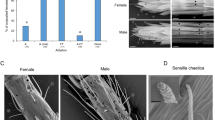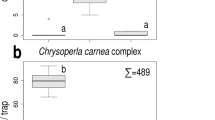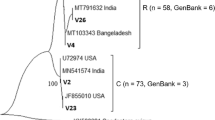Abstract
IN the course of investigational work on Platyedra gossypiella, the pink bollworm of cotton, in the West Indies, observations were made on its nocturnal habits, concerning which but little is known. On the question of light attraction, for example, there has been a stalemate of opinions. Wilcocks1 in Egypt found that both sexes came to light readily ; while Busck2 in Hawaii states that the moth is not attracted to light “but is on the contrary shy of all light, natural and artificial”. “The idea”, he writes, “that moths were attracted to light is based on very unsatisfactory evidence and is probably due to a misidentification of material collected in the traps”! In St. Vincent, B.W.I., light attraction is evident from 8 p.m. to 4 a.m., when it fails rapidly. By 5 a.m., though it is still dark, the moths are hiding as by day. In Egypt, Ballou3 found that there were always some moths that were not attracted. This difference has also been observed in St. Vincent and is not due to age, sex or condition. Attraction is strongest during the mating period. Wedded pairs are readily attracted, but in all cases prolonged exposure tires the response. There is no noticeable difference between the behaviour of long- and short-cycle moths.
This is a preview of subscription content, access via your institution
Access options
Subscribe to this journal
Receive 51 print issues and online access
$199.00 per year
only $3.90 per issue
Buy this article
- Purchase on Springer Link
- Instant access to full article PDF
Prices may be subject to local taxes which are calculated during checkout
Similar content being viewed by others
References
Wilcocks, F. C., “The Insect and Related Pests of Egypt Injurious to the Cotton Plant”, Ministry of Agriculture, Egypt (1916).
Busck, “The Pink Bollworm (Pectinophora gossypiella)”, J. Agric. Res., 9, No. 10 (1917).
Ballou, H. A., “Cotton and the Pink Bollworm in Egypt”, West Indian Bull., 17, No. 4.
Author information
Authors and Affiliations
Rights and permissions
About this article
Cite this article
SQUIRE, F. Nocturnal Habits of Platyedra gossypiella Saunders. Nature 140, 69–70 (1937). https://doi.org/10.1038/140069a0
Issue Date:
DOI: https://doi.org/10.1038/140069a0
Comments
By submitting a comment you agree to abide by our Terms and Community Guidelines. If you find something abusive or that does not comply with our terms or guidelines please flag it as inappropriate.



